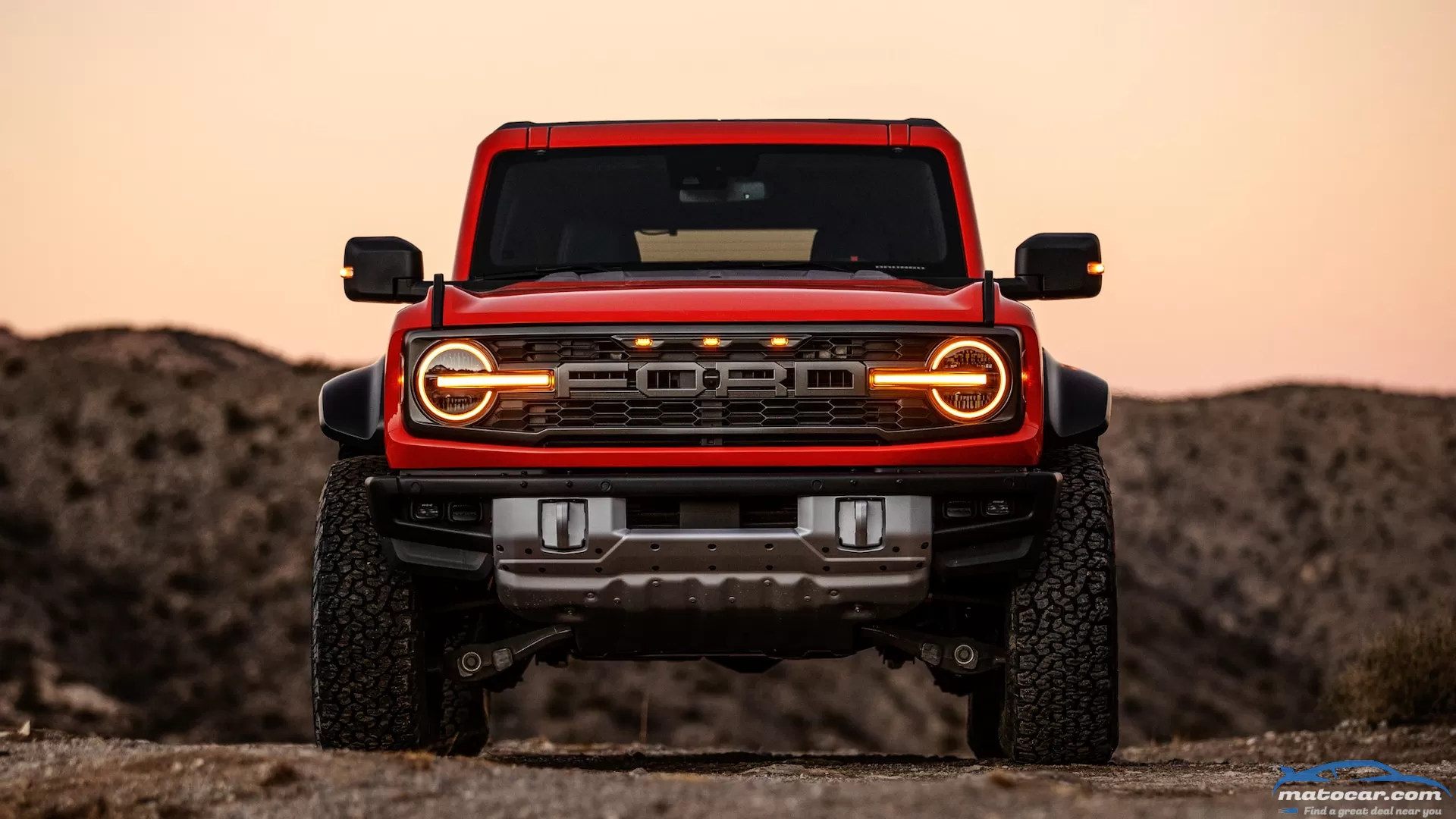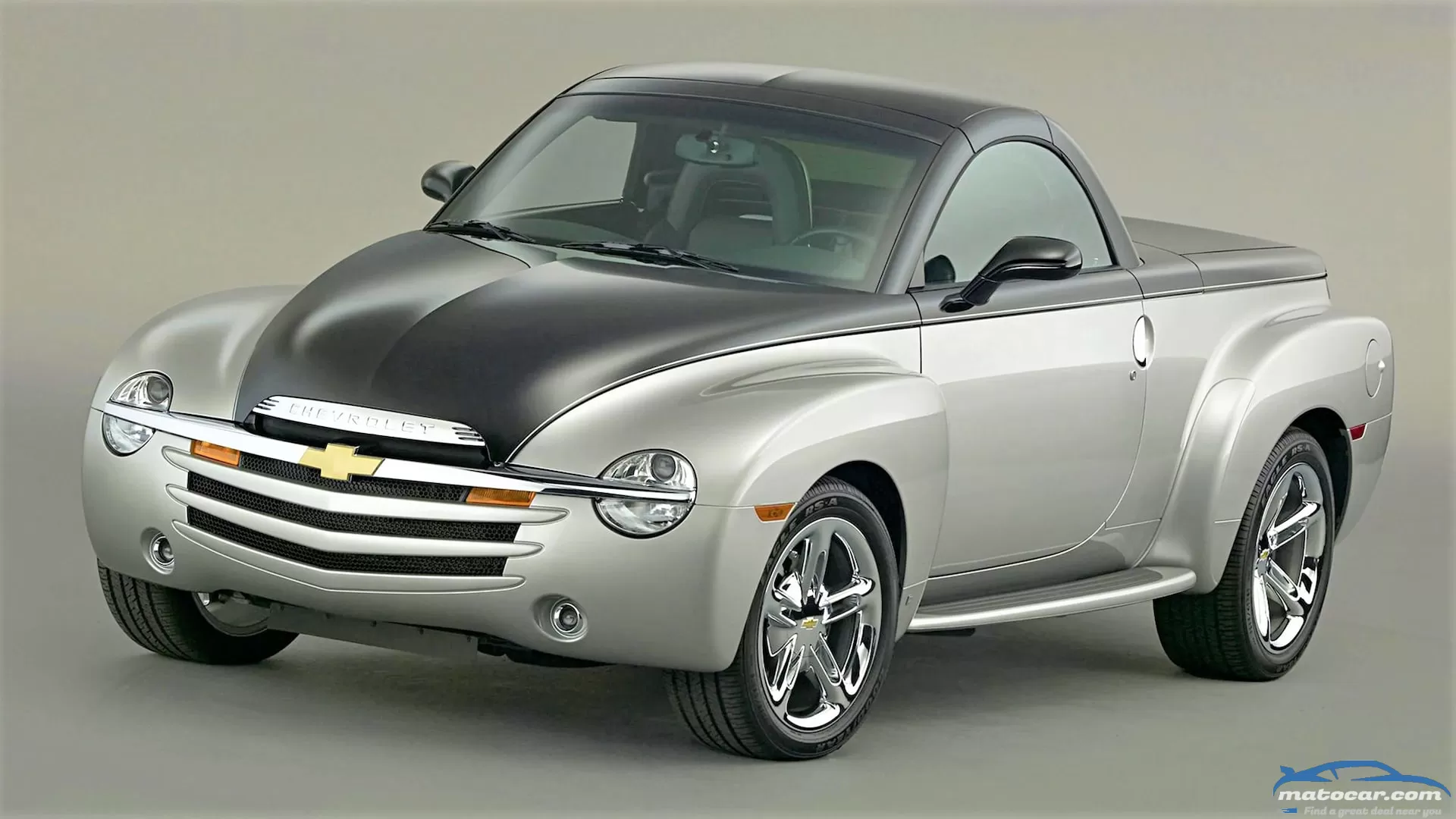So, the New Ford Bronco Raptor Is Here—Where's Its V-8 Engine?

Ever since spy shots of the flare-fendered, camouflaged 2022 Ford Bronco Raptor started hitting the airwaves, the internet has been buzzing as to whether it would be powered by an EcoBoost V-6 (and if so, which one?) or a Coyote V-8. Folks were clearly crossing their fingers for the latter, to relive those Bill Stroppe Baja fantasies. Now that the Bronco Raptor has dropped, we know we're getting the 3.0-liter twin-turbo EcoBoost six, and hearing the reasons why, we don't begrudge the decision. So read on for the answer to "Why no Bronco V-8?" and to learn how you will be able to buy a Bronco V-8 from Ford—sort of.
Just Not a Good Fit
As we've noted extensively, the Bronco is based on next-generation Ranger architecture, which involves a noticeably narrower frame than the one used by the F-150. Further tightening the engine compartment are shock towers that are elevated to provide the added suspension travel crucial to the Bronco Raptor's desert-blitzing capabilities. These taller towers prevent turbos and cylinder heads from being able to hang over the main frame rails. Such package constraints conspire against fitting a V-8 or even the wider 3.5-liter EcoBoost V-6 in a Bronco Raptor engine bay.
So when some aftermarket tuner comes along with an Bronco V-8 transplant, inevitably wearing Poppy Red, white, and blue livery, you'll likely learn that that specific Bronco didn't start life as a Raptor (and you may rightly fret about its cooling performance and durability).
Nose Heavy?
Extra weight on the nose of a desert racer is never a good thing. It overworks the springs and dampers, causes the front end to plow, adds wear to the front tires, and more. And although the overall weight of the Coyote V-8 isn't that much different from that of the EcoBoost V-6 engines (turbos weigh more than pistons!), the V-8 is longer, moving the engine's center of mass forward. This would have the effect of adding weight to the nose of a Bronco V-8.
Out of Character
This most extreme example of the "Born Wild" Bronco cries out for the broad, flat torque curve that comes with a twin-turbo engine. Naturally aspirated V-8s can't typically match this torque-everywhere character that a twin-turbo EcoBoost engine provides. And in any case, if our estimates of power and weight are correct, the Bronco Raptor should roughly hit the weight-to-power and hence 0-60-mph acceleration of the similarly tired Ford F-150 Raptor 37.
You CAN Have a Bronco V-8!
Wait, what? That's right, Ford is building a Bronco with a V-8. You simply won't be able to drive it to your local cars and coffee, or on public roads in general, but maybe you could live out your Stroppe fantasies and win the SCORE Baja 1000 race in it. We're talking about the 2023 Ford Bronco DR, a not-street-legal off-road-racing Bronco available to privateer racers.
Buy one of these, and you'd also be living out a "Rod Hall and Larry Minor" fantasy—they won the Baja 1000 overall in a stock Bronco V-8 in 1969. This tube-frame racing truck faces none of packaging dilemmas that plague the production truck, so it will run a V-8. It'll also package the radiator behind the driver. Oh, and it'll cost in the mid-$200,000s when it goes on sale this fall. How badly do you want a Bronco V-8?
You may also like
Funky riffs on SUVs, crossovers, and trucks have been common enough throughout the past two decades, but back near the turn of the century, automakers concocted all sorts of products that landed with a splash but never took the market by storm. Nowadays, trucks with enormous horsepower figures like the Ram TRX or coupelike SUVs such as the BMW X6 are sought after by buyers with the desire (and the cash) to drive something a bit more radical than everyone else. Check out these 10 vehicles from the relatively recent past that would have been seen as much cooler if they first came to market today.
ferrari daytona-sp3 Full OverviewThe tach needle breezes past 8,000 rpm and keeps going. There's a keening edge to the metallic yowl filling the open cockpit, and the acceleration isn't letting up. Suddenly, I'm a wide-eyed 13-year-old at the movies again, riding along with Erich Stahler as he hammers his Ferrari 512 S flat-out down the Mulsanne Straight in Steve McQueen's epic film Le Mans.This is what that sounded like. And this is what I always imagined it felt like. A mid-engine Ferrari V-12 at nearly 9,000 rpm.Blue lights flicker across the top of the steering wheel. The 828 horses behind me are stampeding toward the engine's 9,500-rpm rev limit. I keep my right foot buried and tug the right-hand paddle, and there's a hard, clean crack from the exhaust, like a .30-06 fired deep in the woods. The tach needle drops to just below the 8,000 mark, and the banshee-mad rush continues unabated as the big, red roadster storms through the French countryside.Wrapped in jaw-dropping bodywork that controversially combines classic '60s curves with 21st century aero brutalism, the Ferrari Daytona SP3 is pure theater on wheels. This car unashamedly celebrates why you'd spend more than $2.2 million on an open-top Ferrari; the sound, the fury, the wanton magnificence of an engine format that's powered some of Maranello's greatest racing cars.A Cordial MissileBut you don't have to suffer for its art. Once you get used to the width of the rear fenders and the low clearance up front—using the standard nose lift system is essential when negotiating driveways or speedbumps—the Daytona SP3 is as benign and easy to use as a Ferrari 296 GTB. You could easily drive this thing every day.The Daytona SP3 is the latest in Ferrari's Icona series, a range of limited-edition cars handbuilt at Maranello using key components borrowed from previous Ferrari production cars. Just 599 will be built, and all have been sold despite that stratospheric price tag. The first of around 150 total cars for U.S. Ferrari enthusiasts arrives stateside in the second quarter of 2023.Although Ferrari engineers say about 70 percent of the Daytona SP3's components are new, the chassis is a modified version of the LaFerrari Aperta hypercar's carbon-fiber monocoque. The suspension layout and geometry are identical, as are the giant 15.7-inch front and 15.0-inch rear brakes.Like the LaFerrari, the Daytona SP3 is fitted with 20-inch front and 21-inch rear wheels, though the Pirelli P Zero Corsas, 265/30 at the front and 345/30 at the rear, have been specifically developed for the car to maximize stability in low grip conditions.That Engine—That Glorious EngineThe Daytona SP3's 6.5-liter V-12 is a modified version of the front-engine 812 Competizione coupe's powerplant. Codenamed F140HC, it is the most powerful internal combustion road car engine ever built by Ferrari.The F140HC makes its 828 horsepower at a dizzying 9,250 rpm and pumps out 514 lb-ft of torque at 7,250 rpm. That 9,500-rpm top end comes courtesy of new titanium connecting rods, which are 40 percent lighter than equivalent steel items, as well as new pistons, a lighter and rebalanced crankshaft, and sliding finger cam followers, a low-mass/low-friction technology borrowed from Ferrari's F1 engines.The first two Icona cars, the Monza SP1 and Monza SP2, evoked the spirit of front-engine Ferrari barchettas from the 1950s. The wasp-waisted Daytona SP3's voluptuous haunches and close-coupled cockpit channels mid-engine V-12 Ferrari race cars from the late '60s and early '70s.The Daytona SP3 is not as pretty as any of those cars, especially the gorgeous 330 P3 and P4, or the 512 S, but Ferrari design chief Flavio Manzoni says it's not meant to be a simple homage, a retro car. It's meant to be a modern interpretation of the spirit of those classic Ferraris, built in a modern way, using modern materials and modern technologies. That's why 2020s aerodynamic theory has played just as much a part in shaping the Daytona SP3 as 1960s nostalgia.The flics underneath the hooded headlights increase downforce at the front axle, for example, and surfaces on the front fenders and doors control airflow along the side of the car. Chimneys bring air from underneath and direct it past the rear haunches, over the top surface of the engine cover, and toward the subtle rear spoiler.It's clever stuff: Ferrari says the Daytona SP3 generates just over 500 pounds of downforce at 125 mph without any active aerodynamic devices.Interfacing With the MachineYou sit low in the Daytona SP3 and toward the center of the car, just as you would in a sports prototype racer. The seats are fixed, their basic shape integrated into the composite central tub and covered with foam. Tugging on a nylon strap at the front of the seat, between your legs, allows the pedal box to move fore and aft, and the steering wheel is also adjustable for reach and rake. Ferrari says the fixed seating reduces weight and helps keep the car's overall height to just 45 inches, which also helps minimize drag.The Daytona SP3's steering wheel features the same Human-Machine Interface (HMI) concept used in the 296 GTB, among others. Touch controls allow drivers to operate 80 percent of the Daytona SP3's functions without moving their hands off the steering wheel. Controls to switch the lights on and off, adjust the exterior rearview mirrors, and change the air conditioning settings are on haptic touch pads on the dash.The Manettino switch on the steering wheel activates four drive modes under the watchful aegis of an upgraded version of Ferrari's ingenious Side Slip Control system dubbed SSC6.1. Wet is for conditions when traction is at a premium. Sport is the default drive mode, and Race sharpens engine, transmission, and chassis responses. GT-Off gives the driver total control.The Daytona SP3 is the first mid-engine V-12 Ferrari to have the Ferrari Dynamic Enhancer (FDE) system that will allow drivers to drift the car if they want, automatically keeping the maximum yaw angle under control by adjusting the brake pressure at each wheel. FDE can be activated with the Manettino switched to Race and GT-Off modes.Even with the roof removed and the scissor door wide open, you need a snake-hipped wriggle to get past the protruding corner of the dash and into the driver's seat without kneecapping yourself. As you settle in and push the pedal box into the correct position, you'll notice the front tire right there, just past your left knee. Your feet are just behind the front axle centerline in a car with a 104.3-inch wheelbase.Cabs don't come much more forward than this.The Alcantara on the driver's seat spills over the vestigial center console and onto the passenger seat, almost giving the impression you've settled into a fancy bench seat. Two slim headrests wrap around like wings, ready to cradle a crash helmet. There's Alcantara on the padding on the doors and on the dash, and small mats on the floors. Pretty much everything else is naked carbon fiber.The SP3 ExperienceThumb the Engine Start-Stop logo on the steering wheel, and there's none of the turbine-like wind-up so typical of a V-12 start: The F140HC simply crackles into life and settles to a brisk idle. Even before you touch the throttle, it feels like an engine with low reciprocating masses.With the Manettino set to Sport and the seven-speed dual-clutch transmission left to its own devices, the Daytona SP3 will happily amble around all day at low to middling speeds, requiring little more effort to drive than a Toyota.The fixed seats are surprisingly comfy, and the ride is surprisingly supple despite the tight rein on the body motions and the contour-hugging low-profile tires. If the tarmac gets too gnarly, a quick press on the Manettino activates the Bumpy Road mode to further soften the ride.The bulging front fenders frame your view ahead, just as they do in a Le Mans sports prototype. The external rearview mirrors are mounted on them, right at the front axle line. They work brilliantly, providing an excellent view past the Daytona SP3's voluptuous hips.As there's no rear window, the internal mirror displays an image from a rear-facing camera. On a sunny day, with the roof off, it's useless, reflections obscuring everything. But as Raúl Julia said in The Gumball Rally as he ripped the rearview mirror off his Ferrari 365 GTB/4 Daytona Spider: "What's behind me is not important."Maybe it's an open-top Daytona thing…With all that power and torque moving barely 3,500 pounds, the Daytona SP3 feels impressively fast and light on its feet. Then you flick the Manettino to Race and the transmission to manual and … oh, lordy!It's Certainly PerformantFerrari claims the Daytona SP3 will sprint from 0 to 62 mph in 2.9 seconds (they say 2.85, but we round up) and hit 124 mph in 7.4 seconds on the way to a top speed of 211 mph. There are cars that are quicker through their gears and cars that are faster at the top end. But there's nothing that feels like this Ferrari on a full-throttle run.The rush of power from the screaming F140HC simply keeps building and building and building, right to the rev limiter. The Daytona SP3 feels like it will accelerate forever.Smooth and free-spinning and wonderfully tractable from little more than idle speeds, the F140HC is a masterclass in the art and science of the naturally aspirated V-12 engine. Its throttle response above 7,000 rpm is simply stunning, as crisp and sparkling as vintage champagne. It barks like a hot-rodded superbike engine on downshifts, the revs snapping so fast it's hard to believe it displaces 6.5 liters.It makes most big-horsepower V-8s feel as clumsy as barroom brawlers 15 beers in, punching the walls.It's not all about the engine, though. Maybe it's because you expect the extravagantly proportioned, extravagantly priced Daytona SP3 to be little more than a rich man's plaything, more for show than serious go, it comes as a genuine surprise to discover than when driven as hard as you dare, it stops and steers and goes around corners with the casual aplomb that's fast becoming a Ferrari trademark.Underneath the aural and visual theatrics is a serious, fully sorted car, with a chassis that's been set up to help you make the most of that extraordinary engine.The braking is strong and progressive, and the steering is precise and well weighted and delivers great feedback. The SSC6.1 system delivers a ton of traction out of the corners, even in Race mode, without compromising front-end grip when you go to power.It intimidates at first, this Ferrari, not the least because it's big and wide and powerful and costs nearly as much as a Manhattan condo. But after a couple miles it shrinks around you, and before long you're pinballing it from apex to apex like an old Mazda Miata, marveling at its acuity on changes of direction, exalting in the adrenalin rush of acceleration along the straights, and laughing out loud at the unholy mashup of Pavarotti and the Sex Pistols that is the F140HC's manic soundtrack.The Ferrari Daytona SP3 is the very antithesis of a rational automobile. But that's the whole point. It hasn't been designed to set new performance benchmarks, to showcase new technologies, to rewrite the supercar rulebook. It's been created to exhilarate and entertain, to deliver an intoxicating rush every time you punch the gas. To make you feel spine-tinglingly alive when you drive it fast.It's time to hand the Daytona SP3 back. But I just can't resist one more run through the gears. 8,000 … 8,500 … 9,000 … 9,500 rpm. Oh, yes, mission accomplished.Looks good! More details?
We'll keep this brief, given how extensively we've covered the new 2023 Honda Civic Type R's gestation over the past two years or so. From watching it lap Suzuka to watching it lap the Nürburgring to, well, just watching the same camouflaged prototypes again and again and again, we have a good idea about the basic contours of the 11th-generation-Civic-based Type R. At long last, we now know when we'll see the rest of the hot hatchback's details—and, you know, its uncovered body: July 20.Honda has announced that reveal date, and helpfully provided our only peek at the 2023 Civic Type R without any camouflage on it. That darkened photo (we tried lightening it more, to no avail) is above. While full information surely will drop on the 20th—just over one week away—we'll give you some of what to expect from this updated monster: It'll likely continue to be front-wheel drive, and powered by a version of the same turbo 2.0-liter I-4 as the outgoing model. Look for more than 300 hp, a six-speed manual transmission, Brembo brakes, huge tires, a wild wing, and even snappier dynamics than the already sharp-handling last-gen version. Now, with that, let's hope there are no more teasers from here on out.




0 Comments